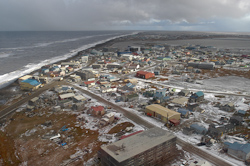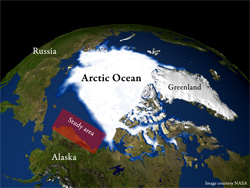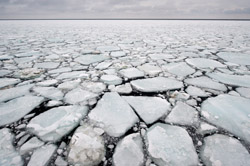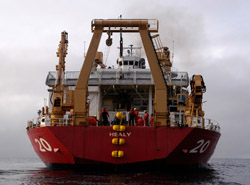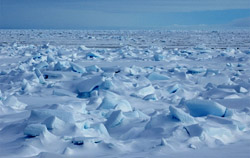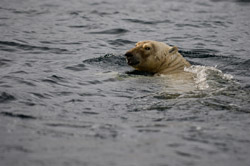The Vanishing Arctic by Dallas MurphyQuallunaat is the Inuit word for “those from the south,” or white people. But it carries a more revelatory implication. Quallunaat are “the people who change nature.” Because their specialized adaptations for survival depend on a perpetual, immutable present, aboriginal cultures must not change the natural order and rhythm of things. That’s why they produce myths, folktales, and narratives, but not history. On the other hand, the industrial/technological culture, eyes ever on the future, must exploit nature to replace the old with the new in order to expand, develop, and prosper. These two cosmologies are inherently irreconcilable. The history of Western exploration demonstrates unambiguously that no aboriginal culture has survived intact its encounter with technological cultures from across oceans, even when no ill will attended. That’s because of our wonderful things. An aluminum skiff with an outboard motor is a better whale-hunting platform than a paddle-powered skin boat. Some modern tools (steel blades, rifles, snow machines) that make their hunting life easier can be folded into Inuit culture without unraveling it—or the balance of nature. Like all adaptation, it’s a matter of degree and time. However, another of our exports to the Arctic has indeed disturbed the balance of nature, thus introducing changes that cannot be adapted to. The entire world is warming, but the warming in the Arctic is more extreme than anywhere else. Arctic-rim cultures have watched their climate lurch from one state (ice) to something approaching its opposite (little or none) in a single generation. It’s not their fault; they emit no greenhouse gasses. Reputable, vocal scientists such as James Hansen, Mark Serreze contend that a seasonally ice-free Arctic Ocean is both inevitable and imminent. Ice is the identity of the Arctic, the foundation of the ecosystem, the entity around which humans and animals have adapted. There is no adapting to its absence. The Vanishing Arctic Many scientists are stating baldly that in the Arctic the climate has already changed. But it doesn’t take a geophysicist to inform the native people that their Arctic is climatically out of joint—the melting sea ice and thawing permafrost are hard to miss by a people whose way of life has always depended on ice. But it is in the nature of Western science to ask specific questions. How have things changed? What exactly has changed? What is the degree of change? In other words, scientists must measure, since the very idea of “change” implies comparative measurements: How is now different from then? But we’re talking about climate change. Climates are enormously complex with myriad components, factors, and forcings that combine over long periods of time to create a set of conditions we call climate. Further, we’re talking about climate change over a vast area spanning multiple environments and adaptation strategies. The Arctic includes an entire ocean, the world’s largest island, and countless seas, bays, straits, islands, rivers, and mountain ranges. Therefore, no single scientific expedition or set of instrumentation can measure “Climate Change in the Arctic.” But a well-planned and staffed series of expeditions and experiments taking repeated measurements of the same specific area can begin to understand a pertinent piece of climate change in the Arctic. That concept brings us to Dr. Bob Pickart’s return to the Western Arctic, his second of five expeditions aboard the US Coast Guard icebreaker Healy—and to this website wherein it will be discussed and explained. The Cruise of the Healy Dr. Bob is a prominent Arctic oceanographer from the Woods Hole Oceanographic Institution, and this is primarily an oceanographic expedition focusing on the western Arctic boundary current off the North Slope of Alaska. One may ask, “If the objective is to measure climate change, why study the ocean?” Or to phrase it differently, “What has the ocean to do with climate?” The short answer, on which we’ll elaborate in this website, is everything. It makes no more sense to talk about climate/climate change without including the ocean than to do so without mentioning air. That said, his cruise, funded by the Office of Polar Programs of the National Science Foundation, is multidisciplinary in the fullest sense, with participation by chemical oceanographers, mammalian biologists, an atmospheric scientist, an ornithologist, and even an Inuit observer. Approaching the climate study from a holistic ecological/environmental perspective, Bob and his team will measure water masses and currents, the movement and thickness of ice, nutrients, dissolved oxygen, phytoplankton, zooplankton, and marine mammals. His team will also deploy a meteorological station to measure changing atmospheric flow patterns. The idea is to collect data and lots of it; that is the only way to understand environmental change, its degree, velocity, and impact. Welcome Aboard This will be a busy, exciting cruise. And we welcome you aboard our fascinating research platform, the icebreaker Healy. We will tell the story of the voyage in the form of daily journals, photographs, and videos. We’ll introduce you to the various scientists, the techniques and methods by which they measure an environment, and we will bring you aboard for a glimpse of life on a Coast Guard icebreaker. In this website, we will approach the story of his cruise from the same eclectic, multidisciplinary spirit with which it was conceived. And maybe, just maybe when the data is in and parsed by the range of scientists for whom it is being collected, we will learn that it is not too late for the Arctic. I for one am delighted to participate in this worthy effort—and to witness this magnificent environment from the deck of an icebreaker. I hope that you, vicariously, will feel the same.
Last updated: September 20, 2010 | |||||||||||||
Copyright ©2007 Woods Hole Oceanographic Institution, All Rights Reserved, Privacy Policy. | |||||||||||||
